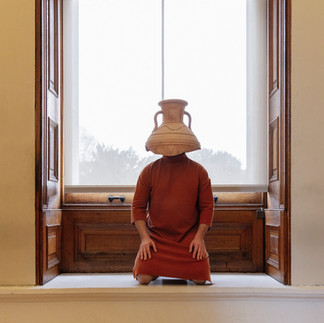Why do we use metaphors of our body such as ‘legs’ and ‘ears’ to describe parts of a clay pot? Why do we indulge in language games that conflate the amphora with a human head, as the word ‘kuza’ in the Cypriot dialect denotes? PASHIAS very literally asks this question by replacing his own head with a fragment of a ceramic pot recently crafted in Cyprus and transported to the Fitzwilliam Museum. PASHIAS’ figure, part-human and part-clay, engages in a dialogue with ceramics exhibited in the museum, which were fashioned from Cyprus’ earth millennia ago.
Archaeologists have put forth various theories regarding the origins of anthropomorphism in pottery: cultural symbolism, religious significance, practical needs of daily life drawing inspiration from our own bodily forms, or, alternatively, the metaphor could be seen as reflecting a universal aspect of human cognition rather than specific cultural or religious beliefs. PASHIAS’ previous work, such as the “Temple-boy” (2017), has explored these speculations. In “Temple-boy” the artist investigates the representation of the human body in a 5th c BC figurine through the notion of metabolism and by linking the ritualistic character of the anthropomorphic artifact with the physiological processes of the human body. However, the current piece suggests a different direction in the artist’s exploration of the topic. In contrast to the 5th c BC figurine which represents in a realistic way the human body, the ‘kuza’ is only its abstraction. It is suggested here that there is something profoundly relatable in the shape and materiality of the amphora that transcends mere resemblance to the human body.
The figure of the artist is a direct reference to this deep material connection of our body to a materialist history, to historic time, to what we coin as ‘heritage.’ What the human/kuza figure alongside the displayed archaeological findings suggests is that our relationship with history and time is not abstract but material, it is recollected as a ‘thing’. This is as a reminder - and how timely this is - that our lives are intertwined with those of others, our contemporaries, predecessors and successors through universal and enduring human needs that remain unchanged over the course of history. All humans suffer the same in the face of thirst, in the face of hunger. The amphorae were made to carry and distribute goods to satisfy these universal needs. In holding the amphora over his head with a gesture of a loving cuddle that surrounds his head/kuza, the artist holds simultaneously the universal head of humanity. With references to revolutionary ideas such as those of the Saint-Simonians, the artist assumes the responsibility to influence and shape society. This theme was addressed in earlier works of PASHIAS such as the “Metaphora” (2019), where the artist’s body assumes the structural role of an architectural element to support a (social) structure, or even in “A.B.S. (Training for performance #7)” (2016) where the artist, as a new Titan lifts the weight of the world on his shoulders.
From a different perspective, the figure of the artist/kuza represents humanity as a continuous material presence in our world, extending beyond our individual lifespans. The artifact provides evidence of this continuity in a tangible manner, as one can still discern human fingerprints left by the makers of ancient pottery. Their life’s work and labour are quite literally handed down to us in the form of clay. What could be more direct and corporeal than this? This material evidence of continuity serves as a comforting reassurance that our fleeting existence as individuals is not a futile singularity, but part of a diachronic human body which leaves lasting signs of presence in the span of history. This is a soothing reflection that alleviates the hardships of our everyday life, the loss, and the despair that accompany the contradictions inherent in the human condition.
The direct connection with the artist - whether it be the distant human of the past who left their fingerprints on the amphora, or PASHIAS who situates himself amidst the museum's visitors - encourages us to move beyond considerations of time. The artist's invitation to the visitors of the Cypriot Collection in the museum is to experience in an embodied way the potential of these objects to facilitate meaningful human connections. The interactions between the audience and the artist bear witness to this capacity of the artifact to mediate social relations here and now. These interactions may range from a dynamic of spectator and spectacle to a more intimate gesture of embrace; from an acknowledgment of the artist's contribution to the human experience to simply a reawakening of an uncritical curiosity that we often bury in our adulthood.
Isn't this rediscovery of our connection to materiality and to our fellow humans the essence of overcoming alienation, and of recognizing ourselves within the objective world we construct?
Dimitirs Venizelos, Curator
* The live performance “KUZA” was commissioned by the Cultural Section of the High Commission of Cyprus - UK, more information: www.pashias.art/kuza
The moments were captured by Dimitris Venizelos and Elodie Giuge.











































